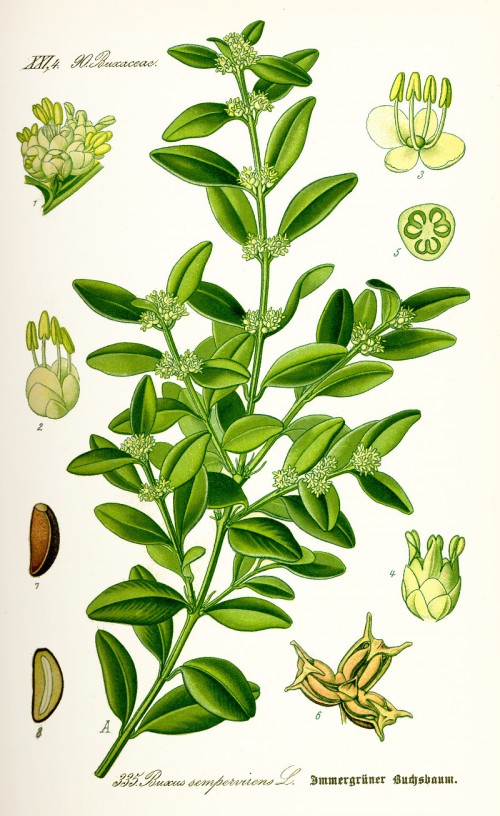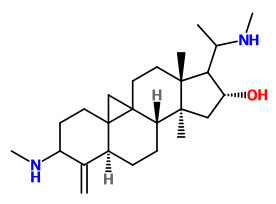Dies ist eine alte Version des Dokuments!
Buxus sempervirens L. - Buxaceae - European box, common box, boxwood, boxtree, Buchsbaum
Evergreen shrub or small tree, native in Europe, Mediterranean, North Africa, West Asia; 0.30-4m, as tree up to 8m; leaves ovate, emarginate,leathery; flowers yellowish-white.
„The boxwood is poisonous in all parts; it contains about 70 alkaloids, including Cyclobuxin D. Leaves and bark have a total alkaloid content of 3%… Boxwood has already been used in antiquity for coughs, stomach and intestinal diseases and against recurrent fever like malaria.“
http://de.wikipedia.org/wiki/Buxus_sempervirens
„In aqueous media of low ionic strength (Na+ = 6 × 10−3M) the alkaloid cyclobuxine, a steroidal diamine, exerts a profound effect on the stability of helical polynucleotides (DNA, S-RNA and dAT:dAT). This effect is biphasic in the sense that at low concentrations of the agent (≤ 10−4M) there is stabilization of the native, while at higher concentrations (≥5 × 10−4M) there is stabilization of the denatured conformation. In a medium containing 51% methanol only the labilizing interaction persists while at high ionic strength both types of interaction are eliminated. These effects of cyclobuxine are restricted to the reversible order—disorder transition and do not extend to strand separation or re-combination.“
[Nucleic acid interactions. V. Effects of cyclobuxine., Mahler, H.R., Dutton, G., Journal of molecular biology, Vol.10(1), 1964, 157-175]
„The acetonic extract of Buxus sempervirens showed cytotoxic activity towards all the five studied breast cancer cell lines with an IC50 ranging from 7.74 µg/ml to 12.5 µg/ml. Most importantly, the plant extract was less toxic towards MCF10A with an IC50 of 19.24 µg/ml. Fluorescence-activated cell sorting (FACS) analysis showed that the plant extract induced cell death and cell cycle arrest in G0/G1 phase in MCF7, T47D, MCF10CA1a and BT-20 cell lines, concomitant to cyclin D1 downregulation.“
[Acetonic Extract of Buxus sempervirens Induces Cell Cycle Arrest, Apoptosis and Autophagy in Breast Cancer Cells, Ouardia Ait-Mohamed et al., 2011]
http://www.plosone.org/article/info%3Adoi%2F10.1371%2Fjournal.pone.0024537#pone-0024537-g006
„… extracts of the aerial parts of Buxus sempervirens growing naturally in Turkey were investigated against acetylcholinesterase (AChE) and butyrylcholinesterase (BChE) as well as tyrosinase (TYRO) enzymes for their inhibitory activity using ELISA microplate reader. Antiprotozoal activity of the extracts was tested against the parasites; Plasmodium falciparum (malaria) and Trypanosoma brucei rhodesiense (human African trypanosomiasis) at 0.81 and 4.85 μg/mL concentrations. As antioxidant activity contributes to antimalarial activity, the extracts were also tested for their 2,2-diphenyl-1-picrylhydrazyl (DPPH) radical scavenging activity, iron-chelating capacity, and ferric-reducing antioxidant power (FRAP). Total phenol and flavonoid contents in the extracts were determined spectrophotometrically. The alkaloid fraction of the chloroform extract afforded two major alkaloids named (+)-buxabenzamidienine (1) and (+)-buxamidine (2). Our results showed that, except for the petroleum ether extract, the extracts displayed high antimalarial and anti-BChE effects as well as quite high iron-chelation capacity.“
[Exploration of cholinesterase and tyrosinase inhibitory, antiprotozoal and antioxidant effects of Buxus sempervirens L. (boxwood), Orhan Ilkay Erdogan, Erdem Sinem Aslan, Senol Fatma Sezer, Kartal Murat, Sener Bilge, Industrial Crops and Products, Vol.40, 2012, 116-121]

Thomé, O.W., Flora von Deutschland Österreich und der Schweiz, Tafeln, vol.3, t.335 (1885)
http://plantgenera.org/species.php?id_species=169351

